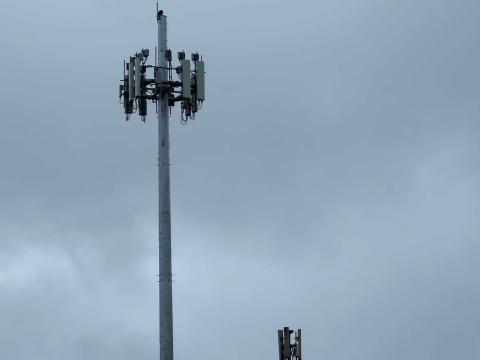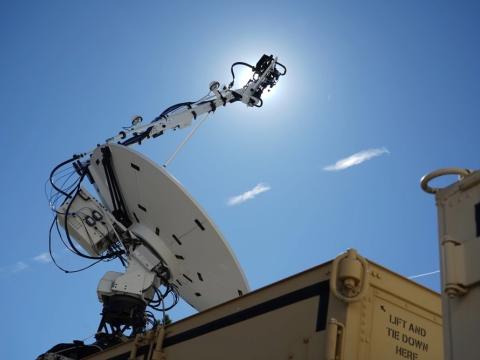Many Threads Weave Big Picture
Data fusion, information sharing technologies link allied forces.
Future commanders may benefit from an enhanced situational awareness and battlefield management system that fuses sensor and information feeds to create a coherent picture of an engagement. The system will permit data to be relayed, shared and analyzed by allied joint forces across multiple echelons.
In the past few years, computer and sensor systems have provided leaders with unprecedented amounts of information. Ongoing programs seek to harness this raw data with architectures that outperform and break opposing forces’ decision cycles.
The single integrated ground picture (SIGP) program will provide commanders with enhanced situational awareness and understanding of their tactical position. The SIGP is a component of the U.S. Defense Department’s family of interoperable operational pictures (FIOP), which consists of the single integrated air picture, the special forces picture as well as maritime and space pictures. The FIOP initiative will develop a series of linked information systems that create a coherent and scalable view of the battlefield. According to Anthony Lisuzzo, director of the U.S. Army Communications-Electronics Command’s Intelligence and Information Warfare Directorate, Fort Monmouth, New Jersey, FIOP is a multiservice initiative covering activities from combat to combat service support across all echelons from combatant commanders down to individual warfighters.
Although administered by the Army, the FIOP, according to Lisuzzo, is not an Army-centric but rather a joint program. The SIGP is designed to offer a modifiable and scalable capability to meet individual commanders’ needs at every level. A tactical officer and a joint task force commander will have the same SIGP capabilities, but these will be tailored to the specific requirements and preferences of those officers based on their mission roles and the knowledge requirements of their echelons, he explains.
The SIGP forms a framework within a system of systems that collects, visualizes and analyzes battlefield data. The program will identify potential imaging and resource management systems. Once integrated, these technologies will create a picture for warfighters indicating a unit’s current location, battlefield situation, available resources and the status of friendly or known enemy forces. To achieve this, the SIGP is leveraging information technologies and innovative concepts from across academia, government and industry; performing experiments in coordination with the U.S. Joint Forces Command; and conducting risk mitigation of selected concepts.
The system uses correlated near-real- and real-time data that is scalable and filterable to support situational awareness and aid in engaging ground targets. Information is provided via maps and a series of overlays, resource tables, charts and reports. The program also is exploring advanced human interface technologies to provide warfighters with critical data while preventing information overload. These may include a variety of collaborative and decision-making technologies; however, Lisuzzo notes that researchers have not yet determined an optimal tool suite for the SIGP.
As new tools are identified, the program will introduce them into the modeling, simulation and experimentation phase to determine their applicability. To ensure SIGP capabilities are interoperable, the most promising applications will be evaluated through joint experimentation and testing, he says. This work will be conducted in conjunction with the Joint Forces Command Joint Battle Center, Suffolk, Virginia, for further combat evaluation.
Lisuzzo describes the SIGP program’s overarching vision as providing warfighters with the ability to see first, understand first and act first. To ensure that they see the enemy first, the SIGP will integrate data from multiple sensors into a single, coherent picture. Units will detect, identify and track individual enemy and friendly forces. Achieving this capability requires leveraging advanced intelligence, surveillance and reconnaissance technologies combined with a variety of air, ground and space sensors networked and integrated into the SIGP. “This will enable us to see the enemy—both whole and in part—as a complex, adaptive organization,” he says.
Lisuzzo notes that the minimum requirements for the SIGP to detect the enemy first are intelligence collectors; combat identification systems; organic sensors that are robotic, multispectral and disposable; unmanned aerial vehicles; embedded command, control, communications, computers, intelligence, surveillance and reconnaissance; special operations forces, long-range surveillance detachments; and air and ground reconnaissance operations. In addition, the joint Global Information Grid (GIG) and leader training are required.
To understand and predict an enemy’s actions, the SIGP will create an integrated battlefield picture that permits commanders at all levels to simultaneously observe, share and analyze data via collaborative planning technologies. By tapping the collective expertise of officers across multiple echelons, the system can identify enemy strengths, locations and disposition, Lisuzzo offers. The collaborative information sharing and planning tools then permit solutions to be conceptualized and disseminated to the appropriate units and levels.
These tools include a knowledge-based battle command system and an execution-centric command and control (C2) system that is more sophisticated than current C2 on-the-move capabilities. But humans remain an important element in the SIGP because the system needs individuals at all levels who are mentally agile, intuitive, adaptive and self-aware to perform optimally, he explains.
While the information dissemination management component of the GIG is a powerful battlefield tool, it is only a part of the picture. “Commanders will never know or understand everything about the battlefield no matter how sophisticated sensors become. Situational awareness and understanding are necessary though not specific prerequisites for achieving battlefield dominance because battlefield dominance means more than being able to see, direct and target. It means that the product of these efforts achieves the desired intent,” he says.
This collected data and expertise ultimately permits commanders and their troops to act first in combat by engaging at the times and places they choose. Lisuzzo notes that instantaneously disseminating a commander’s orders combined with a broad access to the SIGP provides unprecedented opportunities for decentralized decision making. To translate knowledge into decisive outcomes, platforms and systems must be capable of moving, shooting and re-engaging faster than the enemy.
The combined data web provided by the SIGP will enable units to assess options rapidly, act first by understanding when and where they must transition between actions and remain fully synchronized throughout the operation. “As subordinates report their actions, those reports are part of the SIGP. Elements of the force affected by the action learn of it, understand the impact and can synchronize their actions—self-synchronization,” Lisuzzo shares.
By leveraging information technology and information sharing in a knowledge-based decision environment, forces will be able to decisively finish engagements. This is achieved by rapidly transitioning from assault to exploitation operations without allowing the enemy the time or opportunity to regroup or continue fighting on its own terms, he maintains.
A major challenge in developing the SIGP is managing system-of-systems integration processes, candidate technologies and hardware solutions, Lisuzzo explains. Because the SIGP is envisioned as a software-based system of systems, other challenges include coordinating multiple databases, providing data fusion and correlation across multiple echelons, and maintaining security in a joint and coalition environment. As U.S. ground forces transition into lighter, more mobile combat forces, almost perfect—versus simply dominant—battlefield intelligence is imperative to assure acceptable levels of force survivability and effectiveness during maneuver operations, he says.
The effort is intended to create partnerships between program managers and system developers as a normal business procedure to trace proposed SIGP architectures and candidate technology and equipment solutions to FIOP and warfighter requirements. Lisuzzo predicts this will result in significant improvements in cost, schedule and performance of an enhanced SIGP capability.
Lisuzzo emphasizes that the program is still in its infancy. Work is underway to study the overall SIGP architecture and to identify any interoperability shortfalls and other areas where resources must be focused. Analysis will examine both current and future architectures and other research, for example, the command, control and communications on-the-move demonstration, as possible candidates for leveraging into SIGP. This will create a starting point to begin further research and experimentation in the coming years, he says.
The program received no funding for 2002. Lisuzzo notes that some seed money was made available for fiscal year 2003, and in 2004 $4 million will be provided to initiate programs. From 2004 through 2009, the program will undergo a series of capability drops—the addition and integration of new systems into the SIGP—until it is fully integrated into the FIOP.
The first phase of the SIGP will be geared toward legacy systems interoperability based on a Defense Department list of systems, programs and initiatives. Because of a lack of funding for this phase, Lisuzzo notes that he will concentrate on efforts already under his purview such as combat identification, blue force tracking and the distributed common ground system as the initial areas for development.
Phase two of the program will simultaneously examine future systems such as the Army’s Future Combat System and the U.S. Marine Corps’ future expeditionary forces. A major component of this phase is meeting interoperability requirements to increase operational tempo and reduce manpower.




Comments